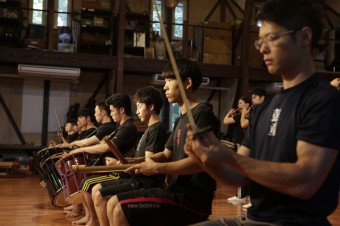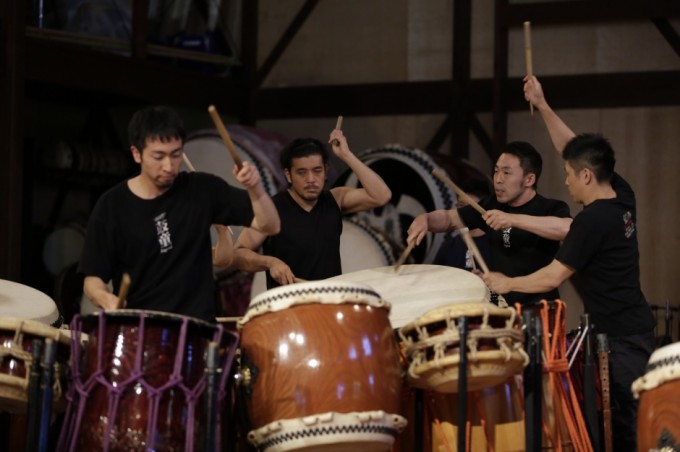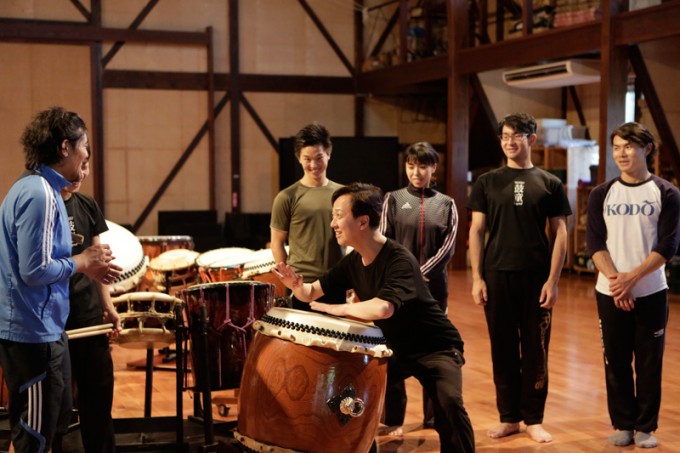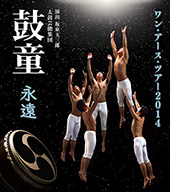Kodo Rehearsal Report: “Eternity,” the Origin of Kodo and Taiko –Part 1–
“Eternity,” the Origin of Kodo and Taiko –Part 1–
Original Japanese Article by Koichi Imai (Freelance Writer) ● Photos by Takashi Okamoto
When I first visited Sado Island, I was impressed by the powerful sun setting beyond the horizon. This autumn, a new Sado Kisen Car Ferry had just been christened the Akane, which means “powerful red,” an image that perfectly captured the essence of that sunset. The name also calls to mind the toki (Japanese crested ibis), a protected species of bird raised with deep care and affection on the Island. I remember thinking that the sunset on Sado captured all of the island’s brilliant natural splendor at once; somehow it was much more dramatic on that day than any other.
While I was watching the rehearsal of Kodo’s new programme “Kodo One Earth Tour: Eternity,” this same feeling came to mind. The rehearsal had a nostalgic feel, like an autumn festival from days past. The warm sounds of the drum and the warmth of the sun setting behind the stage seemed to capture the essence of Sado completely.
By any measure, “Eternity” is a profound and epic title.
Artistic Director Tamasaburo Bando explains this choice as follows:
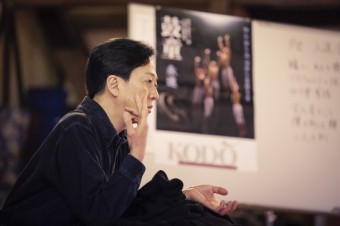
“When I was contemplating the theme of eternity, it occurred to me that ‘the workings of nature’ unfold in cyclical patterns, and that perhaps in identifying those patterns, we could express ‘eternity.’ Strictly speaking, there is probably no such thing as ‘eternity,’ for us mortals, but there are some things that are eternal. The dawn, light, rain, wind, clouds, waves, stars, dusk, the night sky; and amongst all these, I saw ‘human beings.’”
The Rehearsal Hall: A Forum for Trial and Error Filled with Heart, Sounds, and Smiles
The workings of nature have enormous power that cannot be fathomed nor controlled by human intellect. A mysterious life force resides in even the tiniest buds. Perhaps eternity can be found in the different sounds of the taiko used to express the workings of life itself.
The opening piece, Yogiri (composed by Tsuyoshi Maeda), introduces the drama about to unfold as it spreads out into the darkness like a giant projection screen. The high-pitched tone of the orin (Buddhist altar bell) echoes like a cool wind blowing across the Island. Shinobue (bamboo flute) melodies call to mind the musical accompaniments of the autumn festival mentioned above, as various percussion instruments beat the base rhythm. This combination conjures an air of nostalgia for a time gone by, when repeated patterns somehow wove the fabric of our daily lives. At the same time, the sounds of waves and wind intertwine. The lasting effect of this piece is an appreciation of the richness of the nature– the ocean, mountains, et al– on Sado Island.
The beginning and the end of the first half of “Eternity” are enveloped by this unique worldview. It dodges, evades and tickles the audience, in the hopes of exhilarating them with the taiko, before engulfing them in a fiery finish.
Following the okedo drum solo in Katarai (also composed by Maeda), a wide variety of taiko surround one performer, and in turn four performers surround another taiko; this is a very unique positioning that sets the stage for a very unique piece. It calls to mind a free-jazz session.
Maeda explains, “The inspiration for this piece came from a simple suggestion from Tamasaburo: ‘Why don’t you create a piece where a performer is surrounded by taiko?’ The theme of the piece is ‘chatting’ or ‘communicating.’ Each taiko has different ‘words’ (or sounds) that create a conversation between instruments. It is a very simple expression of communication and living as primordial human beings. Tamasaburo considers taiko as a chordal instrument, and I think that he is trying to elicit from us a melody that mixes high and low tones in a giant, complex, undulating wave.”
In the rehearsal hall, the Artistic Director creates pieces together with performers as if he were a member of the group. He decides things in an instant, which reveals his instinctual understanding of all the essential elements, although he doesn’t play the taiko himself. As the Katarai rehearsal continues, he extrapolates and expands on the performer’s ideas, saying “How about doing it like this…?” and then quickly directing them with gestures to continue, saying “Next! Next! Next! Next!” The performers sway to the right and left, their bodies pinned to the sound of the taiko, never giving up. Young performers have become freer and bolder in their movements and sound through his pointed advice. During break time, there is a smile on everyone’s face as the Artistic Director and performers chat and the rehearsal hall vibrates with a palpable energy. The free jazz session transforms into free communication amongst the performers.
▶Watch on YouTube http://youtu.be/8_BHh_OyRVs
Kodo One Earth Tour 2015: Eternity
June 6 (Sat) Ryutopia Concert Hall, Niigata City
June 7 (Sun) Joetsu Bunka Kaikan, Joetsu, Niigata
June 17 (Wed) Sagami Women’s University Green Hall, Sagamihara, Kanagawa
June 19 (Fri) Yokosuka Arts Theater, Yokosuka, Kanagawa
June 20 (Sat) Chigasaki Shimin Bunka Kaikan, Chigasaki, Kanagawa
June 26 (Fri) Pastoral Kazo, Kazo, Saitama
June 27 (Sat) Mikabo Mirai Kan, Fujioka, Gunma
June 28 (Sun) Kimitsu Shimin Bunka Hall, Kimitsu, Chiba
July 3 (Fri) Shin-Kabukiza Theater, Osaka City
July 4 (Sat) Shin-Kabukiza Theater, Osaka City
July 5 (Sun) Shin-Kabukiza Theater, Osaka City
July 7 (Tue) Matsumoto Performing Arts Centre Grand Hall, Matsumoto, Nagano
July 11 (Sat) Kyoto Performing Arts Center Shunjuza, Kyoto City
July 12 (Sun) Kyoto Performing Arts Center Shunjuza, Kyoto City
July 17 (Fri) Yawatahama-shi Bunka Kaikan Yume Mikan Dai Hall, Yawatahama, Ehime
July 19 (Sun) Miyoshi Shimin Hall, Miyoshi, Hiroshima
http://www.kodo.or.jp/oet/index_en.html#schedule17b
Koichi Imai (Freelance Writer)
Koichi Imai became a theater afficionado during his college years, and graduated from Nihon University College of Art. He went on to spend sixteen years working for “Theater Guide” magazine in Japan. Next, he assumed a public relations role at Matsumoto Performing Arts Centre, where he worked for over five years before becoming a freelance editor and writer. Based in the Nagano area, his current work focuses on theater, as well as artists, artisans, and farmers. He is also involved in organizing various events.




